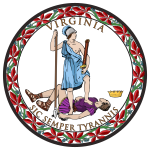| ||||||||||||||||||||||||||
| ||||||||||||||||||||||||||
 County Results
| ||||||||||||||||||||||||||
| ||||||||||||||||||||||||||
| Elections in Virginia |
|---|
 |
The 1932 United States presidential election in Virginia took place on November 8, 1932. Voters chose eleven representatives, or electors to the Electoral College, who voted for president and vice president.
Like all former Confederate States, early twentieth-century Virginia almost completely disenfranchised its black and poor white populations through the use of a cumulative poll tax and literacy tests.[1] So severe was the disenfranchising effect of the new 1902 Constitution that it has been calculated that a third of the electorate during the first half of the twentieth century comprised state employees and officeholders.[1]
This limited electorate meant Virginian politics was controlled by political machines based in Southside Virginia—the 1920 would see the building of the Byrd Organization which would control the state's politics until the Voting Rights Act. Progressive “antiorganization” factions were rendered impotent by the inability of almost all their potential electorate to vote.[2] Unlike the Deep South, historical fusion with the “Readjuster” Democrats,[3] defection over free silver of substantial proportions of the Northeast-aligned white electorate of the Shenandoah Valley and Southwest Virginia,[4] and an early move towards a “lily white” Jim Crow party[3] meant that in general elections the Republicans retained around one-third of the small statewide electorate,[5] with the majority of GOP support located in the western part of the state. However—like in Tennessee during the same era—the parties avoided competition in many areas by an agreed division over local offices.[2]
1928 saw a substantial change, whereby a combination of anti-Catholicism in the Tidewater region and growing middle-class Republicanism in the cities saw Republican Herbert Hoover carry Virginia's electoral votes[6] and elect three Congressmen, including the local district of emerging machine leader Byrd.[7] However, a combination of record drought[8] and the economic catastrophe of the Great Depression meant that the trend towards the GOP would be short-lived.[9] The Depression had extremely severe effects in the South, which had the highest unemployment rate in the nation, and many Southerners blamed this on the North and on Wall Street, rejecting Hoover's claim that the Depression's causes were exogenous.[10]
For some time in 1932, Byrd was seen as a possible compromise candidate between Roosevelt and Al Smith for the Democratic presidential nomination;[11] however, Southern opposition to Smith meant that Byrd ultimately wavered on seeking the nomination and accepted Roosevelt,[12] as even delegates from such states as North Carolina rejected him for FDR.
Neither major party candidate campaigned in the state, and no polls were taken early in the campaign. when the state was finally polled in the middle of October, Roosevelt was clearly leading over Hoover by around five-to-two.[13] A later poll had Roosevelt winning by seventy thousand votes, despite overall being much more favourable to the incumbent president than most other polls.[14] As it turned out, the earlier poll was more accurate, with Roosevelt winning by over one hundred and fourteen thousand votes. Roosevelt ultimately won the national election with 57.41 percent of the vote.
- ^ a b Kousser, J. Morgan. The Shaping of Southern Politics: Suffrage Restriction and the Establishment of the One-Party South, 1880-1910. Yale University Press. pp. 178–181. ISBN 0-300-01696-4.
- ^ a b Key, Valdimer Orlando (1949). Southern Politics in State and Nation. pp. 20–25.
- ^ a b Heersink, Boris; Jenkins, Jeffrey A. Republican Party Politics and the American South, 1865-1968. pp. 217–221. ISBN 1107158435.
- ^ Moger, Allen. "The Rift in Virginia Democracy in 1896". The Journal of Southern History. 4 (3): 295–317.
- ^ Phillips, Kevin P. (1969). The Emerging Republican Majority. pp. 193, 219. ISBN 0870000586.
- ^ Phillips. The Emerging Republican Majority, p. 195
- ^ Hawkes (junior), Robert T. (July 1974). "The Emergence of a Leader: Harry Flood Byrd, Governor of Virginia, 1926-1930". The Virginia Magazine of History and Biography. 82 (3): 259–281.
- ^ Heinemann, Ronald L. (1996). Harry Byrd of Virginia. Charlottesville, Virginia: University Press of Virginia.
- ^ Lewinson, Paul (1965). Race, class and party; a history of Negro suffrage and white politics in the South. pp. 167–168.
- ^ Ritchie, Donald A. (2007). Electing FDR: the New Deal campaign of 1932. Lawrence, Kansas: University Press of Kansas. p. 143. ISBN 070061687X.
- ^ Heinemann; Harry Byrd of Virginia, p. 141
- ^ Heinemann; Harry Byrd of Virginia, p. 143
- ^ "Roosevelt Overwhelmingly". The Tampa Times. October 21, 1932. p. 4-A.
- ^ Pasquino (October 30, 1932). "Non-Partisan Forecast Gives G.O.P. President Edge over Roosevelt". The Idaho Statesman. Boise, Idaho. pp. 1, 6.
© MMXXIII Rich X Search. We shall prevail. All rights reserved. Rich X Search


